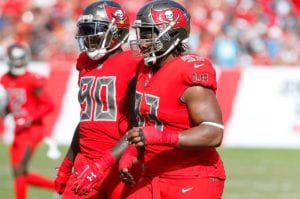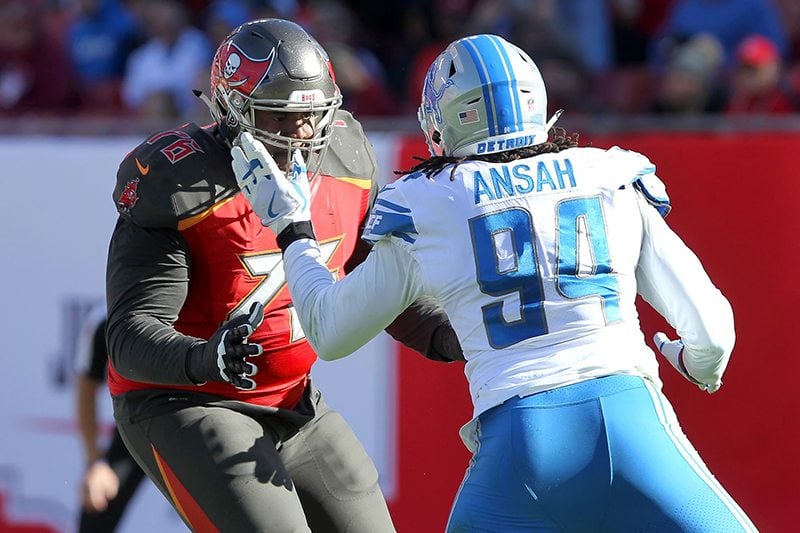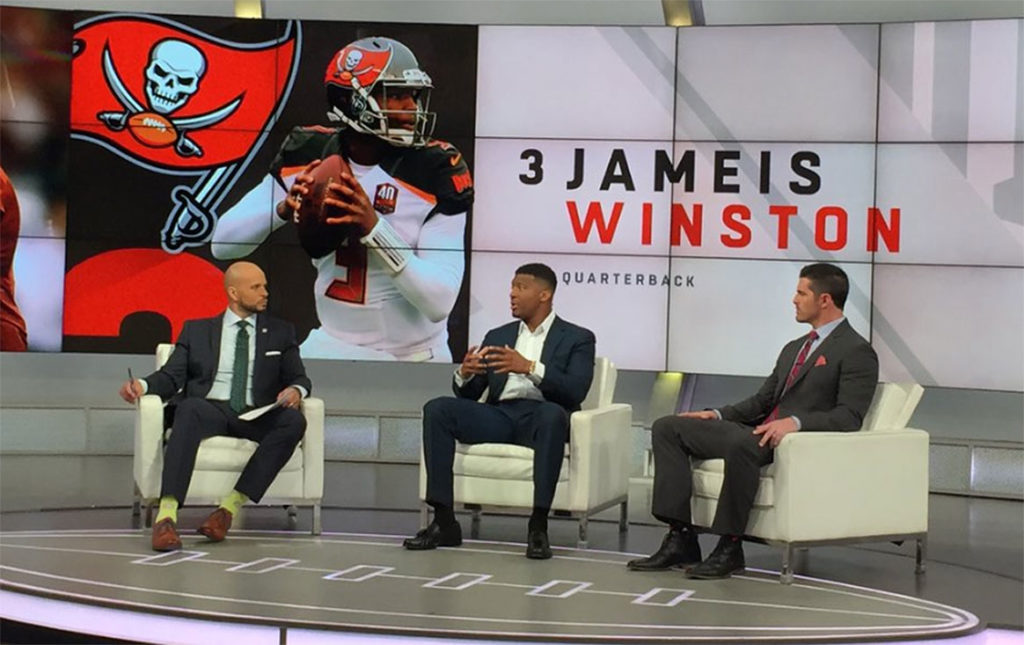According to the NFLPA, the Tampa Bay Buccaneers have the second fewest available salary cap dollars available heading into free agency. Tampa Bay has just $3,350,607 worth of salary cap space after signing left tackle Donovan Smith to a three-year contract extension worth $41.5 million with $12.5 million counting against the cap this season.
Only New Orleans has less cap room as it is currently has to clear $10,300,288 in cap space to be compliant by 4:00 p.m. next Wednesday, March 13, which is the start of free agency.
The Bucs haven’t been this tight against the cap entering free agency since the days of Jon Gruden. That’s due to recent contract extensions over the last two years, including wide receiver Mike Evans ($20 million), left tackle Donovan Smith ($12.5 million), guard Ali Marpet ($11.025 million), tight end Cameron Brate, in addition to Jameis Winston’s fifth-year option year, which will cost the team $20.92 million this season.

Bucs DE Jason Pierre-Paul and DT Gerald McCoy – Photo by: Cliff Welch/PR
Throw in Jason Pierre-Paul’s $14.9 million salary cap charge, Gerald McCoy’s $13 million, Ryan Jensen’s $10 million and DeSean Jackson’s $10 million and Tampa Bay has eight players set to make $10 million or more in 2019 – not to mention linebacker Lavonte David is knocking on the door with $9.75 million this year.
So in order for the Bucs to sign another free agent or tender restricted free agent running back Peyton Barber an offer, general manager Jason Licht and director of football administration Mike Greenberg have to make some moves to clear more cap room. Here are some options for Tampa Bay.
Cut Players That Are Due Roster Bonuses
There are two Buccaneers that are due roster bonuses in the coming week, which could prompt the team to release them or be financially committed to them for the 2019 season.
DT Beau Allen – $1.5 million roster bonus, $3.5 million base salary
DT Mitch Unrein – $1 million roster bonus, $2.75 million base salary
Releasing Allen could have $3.5 million, which is this year’s base salary, and only result in a $1.5 million cap hit to the team. Fellow defensive tackle Mitch Unrein, who suffered a severe concussion during training camp and still had been clearly medically by the end of the season, is set to make $2.75 million in base salary this year with a $3.75 million cap charge. If the team were to release him Tampa Bay save $2.75 million with $1 million worth of dead cap money.
Restructure Big Contracts
Greenberg has avoided restructuring in the past because the Bucs have never really needed to create cap room before, and his philosophy of simply guaranteeing the first year or two of a base salary has sufficed in most contracts up until now instead of giving out signing bonuses, which is money upfront that is spread out evenly over the life of the contract. Teams that give out big signing bonuses can get in trouble with the salary cap down the line if a player needs to be cut or traded before the end of his contract because the prorated signing bonus accelerates and hits as dead cap money.

Bucs director of football administration Mike Greenberg – Photo by: Cliff Welch/PR
For example, if Greenberg gave Evans a $30 million signing bonus when he signed his five-year, $82.5 million contract extension last year, that $30 million that Evans would pocket at the day of his signing would be spread out over the life of his contract, which was six years. So aside from his base salary – whatever that may be in a given year – Evans would have an additional $5 million prorated signing bonus for all six years.
The problem in doing this – and the Bucs used this method under both former general managers Rich McKay and Bruce Allen – is that it can create a lot of dead salary cap money if implemented often. Under this scenario, if Evans underperforms three years from now and the Bucs want to cut or trade him halfway through his deal, when he leaves the team the remaining $15 million worth of signing bonus proration ($5 million for three years) accelerates and hits the salary cap in one year.
That’s $15 million in dead salary cap room for Tampa Bay, which essentially means the Bucs have $15 million less than other teams to spend under the cap for actual players.
Instead, Evans was given a $10 million roster bonus, which is not prorated, when he signed the contract. That, along with his $8.258 million base salary, made his cap value last year $18.258 million. The reason why Evans took $10 million upfront in the form of a roster bonus instead of asking for a $30 million signing bonus was to help the team out by not having any upfront money be prorated in the form of a signing bonus.
In return, the Bucs guaranteed $38.258 million, which was last year’s base salary, last year’s $10 million roster bonus and this year’s $20 million base salary. So Evans got $8.258 million more in guaranteed money by doing it this way rather than taking $30 million guaranteed in the form of a signing bonus.
Now that you know the difference between signing bonuses and Greenberg’s preferred use of roster bonuses and guaranteed base salaries, understand that this might be the year the Bucs have to turn to restructuring, which is taking a base salary and converting a portion of that into a signing bonus. Teams that engage in restructuring pick the players that have remaining years left on their contracts that will likely play with that team for the full duration.

Bucs WR Mike Evans – Photo by: Getty Images
It’s unlikely that Gerald McCoy will remain in Tampa Bay through 2021 when he’ll be 31, especially with cap values of $13 million (2019), $12.5 million (2020) and $12,932,253 (2021) on the horizon in the twilight of his career. Yet it’s highly likely that Evans will be a Buccaneer through the final year of his deal in 2023 when he’ll turn 30. So it makes sense to turn to Evans to restructure as opposed to McCoy.
Because Evans’ $20 million is the largest base salary this year in Tampa Bay, Greenberg and Licht could reduce his cap value down to $12 million this year if the team wanted to, thus creating $8 million in salary cap space with a restructure. By doing that, Greenberg could reduce Evans’ base salary to $10 million in 2019 and give him a $10 million signing bonus. That $10 million would be prorated over the remaining five years at $2 million per year.
Evans would still get his fully guaranteed $20 million this year it’s just that $10 million would be upfront right now as a restructured signing bonus and the other $10 million would come in the form of weekly game checks during the season. Evans’ cap value this year would be lowered from $20 million to just $12 million and Tampa Bay would have $8 million worth of cap room to spend on other players.

Bucs WR Mike Evans – Photo by: Getty Images
What helps in this situation is that Evans’ cap value decreases over the remaining years of his contract as his base salaries are $16.75 million in 2020, $12.25 million in 2021, $14 million in 2022 and $14.5 million in 2023. Adding a $2 million cap charge in each of the remaining years with the signing bonus proration will still keep his overall cap charge under $20 million moving forward. In this scenario, Evans’ cap charges would be $12 million in 2019, $18.75 million in 2020, $14.25 million in 2021, $16 million in 2022 and $16.5 million in 2023.
Greenberg and Licht could create cap room with a restructured deal including a signing bonus with any other player with a high base salary on Tampa Bay’s roster, but Evans is clearly the most likely candidate.
Sign Barber To An Extension
The Bucs are considering using a second-round tender for restricted free agent running back Peyton Barber, which would be a one-year, $3 million contract for 2019. Because Barber was an undrafted free agent, if the team were to use the lower, original-round tender worth $2 million, the Bucs would not receive any draft pick compensation if he were signed to an offer sheet. Barber is expected to start this season in Tampa Bay, so that will force the team to use the higher tender offer to fend off any other potential suitors.

Bucs RB Peyton Barber – Photo by: Cliff Welch/PR
Or the Bucs could approach Barber about doing a short-term extension with more than the $3 million guaranteed. Tampa Bay could offer Barber a three-year deal with $5 million in guaranteed money, including a base salary of $1.5 million in 2019, which would be double what Barber made last year, with a $3.5 million guaranteed base salary in 2020 and an extra year that is not guaranteed tacked on after that at around $4 million.
A proposal like that would help the Bucs’ cap situation in 2019 by getting Barber at a $1.5 million base salary instead of $3 million, thus saving the team $1.5 million in cap room.
Part Ways With Big Money Contracts
Of course the easiest way to create cap room is to make some roster moves by cutting some high-priced players that don’t have any more guaranteed money that could result in a dead cap money situation. The two obvious targets for this type of cap space creation are McCoy and Jackson.
DE Jason Pierre-Paul $13.65 million ($14.9 million cap charge with bonuses)
DT Gerald McCoy – $13 million
WR DeSean Jackson – $10 million
TE Cam Brate – $7 million
DE Will Gholston – $3.75 million
P Bryan Anger – $3 million
G Evan Smith – $2 million
The Bucs traded a third-round pick for Pierre-Paul last year and he responded with a team-high 12.5 sacks. He’s not going anywhere.

Bucs DT Gerald McCoy and DE Will Gholston – Photo by: Getty Images
Licht and Arians have both indicated that they would like for McCoy and Jackson to remain in Tampa Bay, but they stopped short declaring that it would happen when pressed on the subject in interviews with PewterReport.com and other media members at the NFL Scouting Combine in Indianapolis.
It seems likely that Anger and Smith will be released, and the team could be debating whether or not to keep Gholston, who has some position flexibility in a 3-4 defense and is still relatively young at age 27.
PewterReport.com has reported that Brate, who is slated to make $7 million this year in base salary, will not be released or traded, nor will he be asked to take a pay cut.
Scott Reynolds is in his 30th year of covering the Tampa Bay Buccaneers as the vice president, publisher and senior Bucs beat writer for PewterReport.com. Author of the popular SR's Fab 5 column on Fridays, Reynolds oversees web development and forges marketing partnerships for PewterReport.com in addition to his editorial duties. A graduate of Kansas State University in 1995, Reynolds spent six years giving back to the community as the defensive coordinator/defensive line coach for his sons' Pop Warner team, the South Pasco Predators. Reynolds can be reached at: [email protected]




